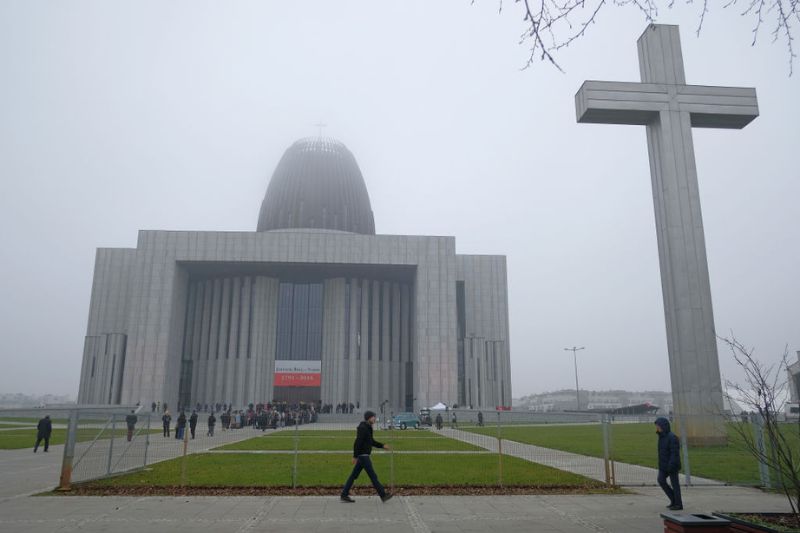Satirical poet Alexander Pope maintained that Some to church repair/Not for the doctrine, but the music there. Well, yes, he had a point, but there are other matters to consider, such as architecture and design, and the contents of churches. I’ve visited many places of Christian worship, and quite a few mosques, but my early church attendance took place with conscientious regularity at a small Presbyterian church in a Wimmera township. The building was a modest weatherboard (keeping it painted must have been a problem) in which the only decoration was the carved pulpit and a strip of blue fleur-de-lis carpet. I can’t even remember any stained glass.

Orthodox churches, with which I became acquainted in my 20s, are entirely different, with the austere stillness of their icons, the blazing of lights, and the iconostasis behind which no woman is permitted to go. And I was certainly not prepared, later, for the glories of Catholic churches in Europe. One of these was St Jacob’s in the Baden-Württemberg town of Pfullendorf, which dates from the 14th century, and was quite overwhelming in its pink-and-white baroque-edging into rococo richness: the cherubs tumbling about in gold-encrusted puffs of cloud or standing tiptoe on gaudy pedestals, or else appearing to fly through the incense-laden air, arrows at the ready. Then there were the trumpeting angels, the pierced hearts with the drops of ruby blood forever falling, the statues of Our Lady, each one framed by a nimbus of glittering stars, and the contrasting ones of Our Lord suffering so starkly and so patiently.
That visit took place twenty years ago, and I still remember it and remember writing about it. It was not long afterwards that Richard Taylor published his fascinating How to Read a Church, which guides people like me through the maze of symbolism and meaning of places like St Jacob’s. And it is only recently that I have learned that the Baroque style, at least when it came to churches, was part of the Counter-Reformation, and a reaction against the austerity of Protestant places of worship.
If I had been unprepared for the sight of St Jacob’s, I was even less prepared for my recent visit to the Temple of Divine Providence in the Wilanow distract of Warsaw, not far from where my son lives. I had to forget all thoughts of the Baroque and Rococo styles, for this enormous structure, set in a wide expanse, dominates the area, and is Brutalist. Definitely. At its highest point it measures 75 metres and is built out of concrete and copper. The ground plan is in the shape of a Greek cross, with all arms of equal length, and the building itself is surmounted by an idiosyncratic dome, which has led to the church being given the irreverent nickname of the Lemon Squeezer.
The idea for the Temple was first mooted late in the eighteenth century but, as happened so often in unfortunate Poland, invasions and wars intervened, and so it was a whole 224 years before the opening of the building took place on Polish Independence Day, November 11, 2016, with the cost of 400 million euros having been largely raised by private donors. The interior has a softer atmosphere, with curved lines rather than vertical ones; an unusual copper crucifix provides a focal point, while around the walls there are portraits of the Catholic great and good. Prominent among these is the picture of martyred Maximilian Kolbe, known for founding monasteries in Poland, Japan and India. He died when he volunteered to take the place of another condemned man in the Auschwitz concentration camp.
The Temple is also known as the Pantheon of Great Poles and is the lasting resting-place for many important citizens, as well as being a national and religious symbol for Poland as a whole. As well, the complex is home to the museum that commemorates the Polish Pope John Paul II, and Cardinal Stefan Wyszynski, Archbishop of Warsaw from 1948 to 1981, and Primate of all Poland. Both these men fought against tyranny in the shape of Nazism and Communism; both helped Jews at crucial times, and both supported the Solidarity movement. During the war, the Cardinal had been wanted by the Gestapo and was also later imprisoned for three years for his anti-Communist activities.
Poland has been Christian since 966 AD, and government statisticians put the numbers of Roman Catholics in Poland as high as 95 per cent of the population: this figure is based on the number of baptised babies. Other estimates stand at 71 per cent, but they also show that over 50 per cent of Poles are practicing Catholics, as against those who are nominal ones. On the day I visited the Temple, there were many of the faithful also visiting, showing their belief in the concept of Providence’s unifying governance and God’s loving care for people.
It's not hard to believe in the statistics.
Gillian Bouras is an expatriate Australian writer who has written several books, stories and articles, many of them dealing with her experiences as an Australian woman in Greece.
Main image: Visitors arrive for a church mass at the Temple of Divine Providence. (Photo by Sean Gallup/Getty Images)